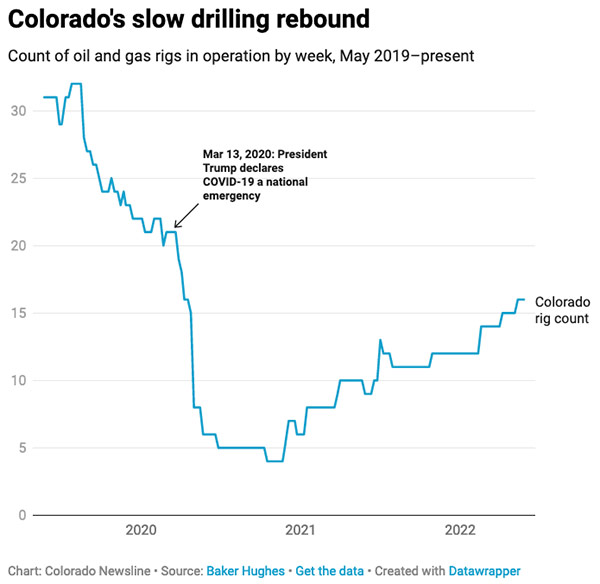This story by Chase Woodruff appeared on Colorado Newsline onJune 2, 2022.
Oil and gas drilling activity has inched upwards in Colorado since the Russian invasion of Ukraine sent prices soaring earlier this year, but investor demands and supply constraints — not state or federal policy — will likely limit production growth through at least the end of the year, a new Colorado School of Mines analysis concludes.
The quarterly report on oil and gas markets from the school’s Payne Institute for Public Policy found that little has changed since the weeks following Russia’s invasion, when multiple large producers operating in Colorado assured Wall Street investors they would use high oil prices to increase dividends and stock buybacks, not expand production.
“The top priority for the U.S. public oil and gas companies remains to deliver higher financial returns to shareholders,” read the report released last week.
Data released by industry consulting firm Baker Hughes show that the number of drilling rigs operating in Colorado reached 16 in May — the highest total since the early days of the COVID-19 pandemic in April 2020, but still just half the number of rigs in operation three years ago.

While rig counts have similarly increased slightly in oil and gas fields across the country, U.S. oil and gas production has declined slightly in the first and second quarters of 2022 due to “weather-related constraints” like heavy snowfall in North Dakota’s Williston Basin, the report said. The industry is also being hit by inflation and supply chain issues, including shortages of steel used in pipes and fracking equipment.
Despite claims to the contrary by industry groups and Republican politicians, government policy hasn’t had a discernible impact on drilling activity, analysts say.
“There is no evidence to suggest that federal policy is having a constraining impact on onshore industry activity,” read the Payne Institute report, noting the thousands of approved federal drilling permits stockpiled by producers. “Rather, the constraints are investor demands for spending discipline and, increasingly, availability of select services.”
Colorado producers still hold more than 1,400 active drilling permits, nearly 1,100 of which lie on private land in the oil-rich Denver-Julesburg Basin in the northeast quarter of the state, according to data from the Colorado Oil and Gas Conservation Commission.
Lobbyists for the industry have sought to downplay its large numbers of approved permits, instead pushing policymakers to roll back environmental protections and climate-change commitments in the name of what American Petroleum Institute president Mike Sommers, in a speech to Colorado business leaders last month, called “regulatory and political certainty.”
In communications to shareholders in recent years, however, Colorado oil companies have rarely attributed significant production impacts to federal and state policy, including a comprehensive new health and safety law passed by Democrats in the General Assembly in 2019. Their year-end 2021 earnings reports, released in March, were full of assurances to investors that they planned to prioritize positive cash flows and shareholder returns, part of an industry-wide shift towards greater “capital discipline” after years of lavish reinvestment in new drilling projects.
Brad Handler, a researcher with the Payne Institute’s Sustainable Finance Lab, concluded in the report that it could be up to a year before domestic oil production could increase significantly as the financial and logistical constraints on the industry gradually loosen, assuming oil prices remain high.
“These pinch points reinforce the idea that production growth likely remains modest, and that employment gains are moderate through 2022,” the report says. “As very strong commodity prices persist and conviction builds that the industry can realize several years of higher prices, O&G companies, reassured by investors, will get more comfortable spending more aggressively.”
